配置msf连接postgresql数据库
我这里是使用kali linux 2016.2(rolling)
用过的博友们都知道,已经预安装好了PostgreSQL。
1、 postgresql启动

/etc/init.d/postgresql start
或者
service postgresql start
2、切换到postgre数据库,进行配置

sudo -u postgres psql postgres (进入到postgre数据库)
alter user postgres with password 'postgres'; //改变用户postgres的密码“postgres ”
即以管理员的身份切换到postgres用户下, psql postgres 即以切换到postgres数据库下。

postgres=# alter user postgres with password 'postgres'; ALTER ROLE postgres=# \password postgres 输入新的密码: 再次输入: postgres=#
注意1:’postgres ’ 这个是密码。
注意2:分号!!!! 一定要带上分号”;”。

注意3:\q:退出数据库
这里,已经进入到postgres数据库了,然后,可以通过\dt来查看,里面的表。

或者
大家也可以这样来,修改linux系统的postgres用户的密码(密码与数据库用户postgres的密码相同)
root@kali:~# sudo passwd -d postgres
passwd:密码过期信息已更改。
root@kali:~# sudo -u postgres passwd
输入新的 UNIX 密码:
重新输入新的 UNIX 密码:
passwd:已成功更新密码
3、当然大家,可以不用PostgreSQL的默认账号,自己新建。(这里我不新建了)(这一步可以跳过)
PostgreSQL数据库创建访问账号。这个zhouls是我自己取的,即创建普通用户,大家可以自己去取。
sudo -u postgres createuser zhouls

然后,切换到postgresql,进行如下配置
设定管理员密码 : \password zhouls
4、进入postgresql数据库的图形化界面
默认是没有的,需要我们手动安装。
apt-get install pgadmin3
如果要在Ubuntu的图形界面启动pgadmin,只需要按下键盘的windows键,在搜索中输入pgadmin,就可以查找到它,点击就可以启动。如果要方便以后使用,可以把它拖到启动器上锁定就行了。
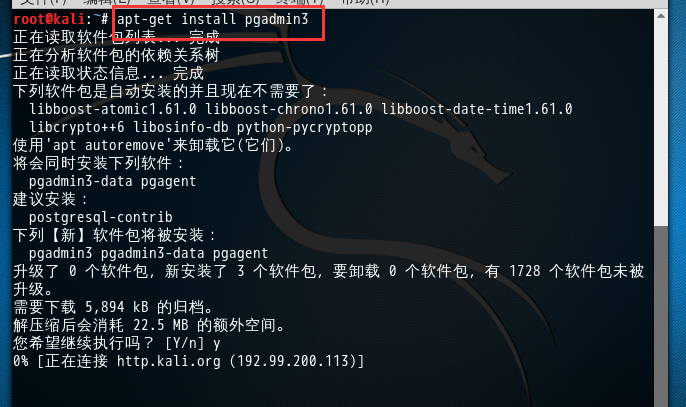
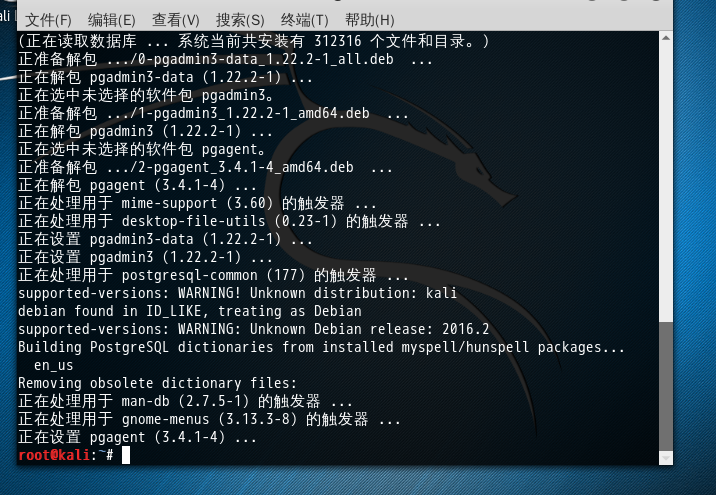
root@kali:~# apt-get install pgadmin3 正在读取软件包列表... 完成 正在分析软件包的依赖关系树 正在读取状态信息... 完成 下列软件包是自动安装的并且现在不需要了: libboost-atomic1.61.0 libboost-chrono1.61.0 libboost-date-time1.61.0 libcrypto++6 libosinfo-db python-pycryptopp 使用'apt autoremove'来卸载它(它们)。 将会同时安装下列软件: pgadmin3-data pgagent 建议安装: postgresql-contrib 下列【新】软件包将被安装: pgadmin3 pgadmin3-data pgagent 升级了 0 个软件包,新安装了 3 个软件包,要卸载 0 个软件包,有 1728 个软件包未被升级。 需要下载 5,894 kB 的归档。 解压缩后会消耗 22.5 MB 的额外空间。 您希望继续执行吗? [Y/n] y 获取:1 http://101.110.118.46/http.kali.org/kali kali-rolling/main amd64 pgadmin3-data all 1.22.2-1 [2,560 kB] 获取:2 http://101.110.118.46/http.kali.org/kali kali-rolling/main amd64 pgadmin3 amd64 1.22.2-1 [3,268 kB] 获取:3 http://101.110.118.42/http.kali.org/kali kali-rolling/main amd64 pgagent amd64 3.4.1-4 [66.1 kB] 已下载 5,894 kB,耗时 57秒 (102 kB/s) 正在选中未选择的软件包 pgadmin3-data。 (正在读取数据库 ... 系统当前共安装有 312316 个文件和目录。) 正准备解包 .../0-pgadmin3-data_1.22.2-1_all.deb ... 正在解包 pgadmin3-data (1.22.2-1) ... 正在选中未选择的软件包 pgadmin3。 正准备解包 .../1-pgadmin3_1.22.2-1_amd64.deb ... 正在解包 pgadmin3 (1.22.2-1) ... 正在选中未选择的软件包 pgagent。 正准备解包 .../2-pgagent_3.4.1-4_amd64.deb ... 正在解包 pgagent (3.4.1-4) ... 正在处理用于 mime-support (3.60) 的触发器 ... 正在处理用于 desktop-file-utils (0.23-1) 的触发器 ... 正在设置 pgadmin3-data (1.22.2-1) ... 正在设置 pgadmin3 (1.22.2-1) ... 正在处理用于 postgresql-common (177) 的触发器 ... supported-versions: WARNING! Unknown distribution: kali debian found in ID_LIKE, treating as Debian supported-versions: WARNING: Unknown Debian release: 2016.2 Building PostgreSQL dictionaries from installed myspell/hunspell packages... en_us Removing obsolete dictionary files: 正在处理用于 man-db (2.7.5-1) 的触发器 ... 正在处理用于 gnome-menus (3.13.3-8) 的触发器 ... 正在设置 pgagent (3.4.1-4) ...
最后把postgresql设置为开机自启
root@kali:~# update-rc.d postgresql enable
启动PostgreSQL数据库图形化管理工具








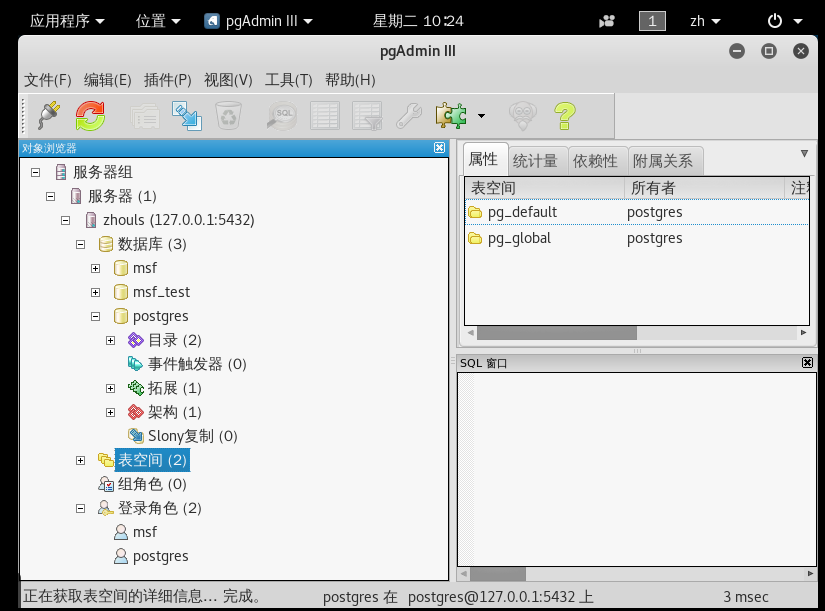
如果是
修改PostgresSQL数据库配置实现远程访问
管理PostgreSQL用户和数据库
配置自动连接
则请见
http://blog.csdn.net/xiongjun_cdn/article/details/51241083
如果大家还有使用BT5的话,则需要安装PostgreSQL(现在一般不用这个BT5了)
一、PostgreSQL数据库安装与管理员密码设定
1、安装PostgreSQL数据库 : apt-get install postgresql
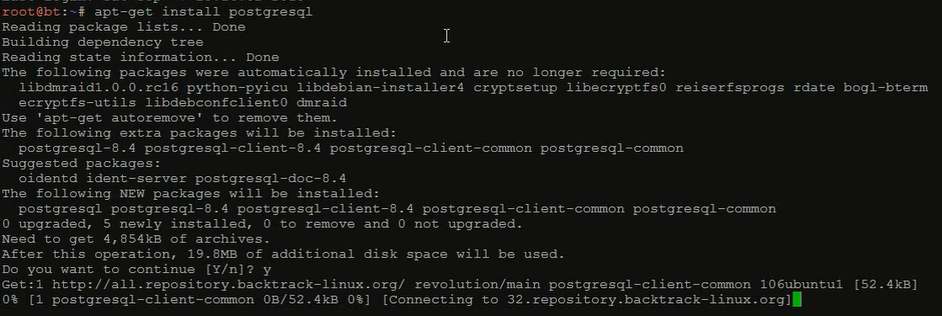
2、切换到postgre数据库 : sudo -u postgres psql postgres

3、设定管理员密码 : \password postgres

4、安装pgadmin3数据库管理程序 : apt-get install pgadmin3
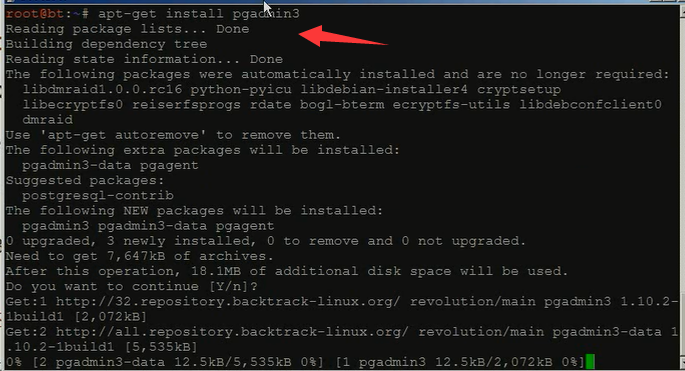
Metasploit终端PostgreSQL的常用命令
查看数据库当前状态: db_status
连接数据库 : db_connect
断开数据库 : db_disconnect
工作空间命令 : workspace
大家,输入msfconsole,即可看到

root@kali:~# msfconsole MMMMMMMMMMMMMMMMMMMMMMMMMMMMMMMMMMMMM MMMMMMMMMMM MMMMMMMMMM MMMN$ vMMMM MMMNl MMMMM MMMMM JMMMM MMMNl MMMMMMMN NMMMMMMM JMMMM MMMNl MMMMMMMMMNmmmNMMMMMMMMM JMMMM MMMNI MMMMMMMMMMMMMMMMMMMMMMM jMMMM MMMNI MMMMMMMMMMMMMMMMMMMMMMM jMMMM MMMNI MMMMM MMMMMMM MMMMM jMMMM MMMNI MMMMM MMMMMMM MMMMM jMMMM MMMNI MMMNM MMMMMMM MMMMM jMMMM MMMNI WMMMM MMMMMMM MMMM# JMMMM MMMMR ?MMNM MMMMM .dMMMM MMMMNm `?MMM MMMM` dMMMMM MMMMMMN ?MM MM? NMMMMMN MMMMMMMMNe JMMMMMNMMM MMMMMMMMMMNm, eMMMMMNMMNMM MMMMNNMNMMMMMNx MMMMMMNMMNMMNM MMMMMMMMNMMNMMMMm+..+MMNMMNMNMMNMMNMM http://metasploit.com Easy phishing: Set up email templates, landing pages and listeners in Metasploit Pro -- learn more on http://rapid7.com/metasploit =[ metasploit v4.12.41-dev ] + -- --=[ 1597 exploits - 912 auxiliary - 274 post ] + -- --=[ 458 payloads - 39 encoders - 8 nops ] + -- --=[ Free Metasploit Pro trial: http://r-7.co/trymsp ] msf > help Core Commands ============= Command Description ------- ----------- ? Help menu advanced Displays advanced options for one or more modules back Move back from the current context banner Display an awesome metasploit banner cd Change the current working directory color Toggle color connect Communicate with a host edit Edit the current module with $VISUAL or $EDITOR exit Exit the console get Gets the value of a context-specific variable getg Gets the value of a global variable grep Grep the output of another command help Help menu info Displays information about one or more modules irb Drop into irb scripting mode jobs Displays and manages jobs kill Kill a job load Load a framework plugin loadpath Searches for and loads modules from a path makerc Save commands entered since start to a file options Displays global options or for one or more modules popm Pops the latest module off the stack and makes it active previous Sets the previously loaded module as the current module pushm Pushes the active or list of modules onto the module stack quit Exit the console reload_all Reloads all modules from all defined module paths rename_job Rename a job resource Run the commands stored in a file route Route traffic through a session save Saves the active datastores search Searches module names and descriptions sess Interact with a given session sessions Dump session listings and display information about sessions set Sets a context-specific variable to a value setg Sets a global variable to a value show Displays modules of a given type, or all modules sleep Do nothing for the specified number of seconds spool Write console output into a file as well the screen threads View and manipulate background threads unload Unload a framework plugin unset Unsets one or more context-specific variables unsetg Unsets one or more global variables use Selects a module by name version Show the framework and console library version numbers Database Backend Commands ========================= Command Description ------- ----------- creds List all credentials in the database db_connect Connect to an existing database db_disconnect Disconnect from the current database instance db_export Export a file containing the contents of the database db_import Import a scan result file (filetype will be auto-detected) db_nmap Executes nmap and records the output automatically db_rebuild_cache Rebuilds the database-stored module cache db_status Show the current database status hosts List all hosts in the database loot List all loot in the database notes List all notes in the database services List all services in the database vulns List all vulnerabilities in the database workspace Switch between database workspaces msf >

msf > db_status [*] postgresql connected to msf msf >

msf > db_disconnect msf > db_status [*] postgresql selected, no connection msf >
创建连接数据库postgres这个在执行下面的命令,它若检测到没有这个数据库的话,则自己会自动去创建好。
对于用户和密码,其实本博文的最上面的我都早就弄好了。
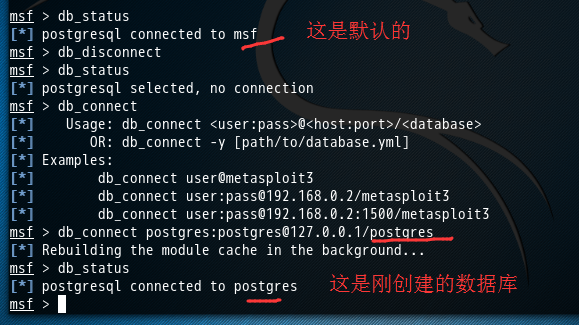
msf > db_connect [*] Usage: db_connect <user:pass>@<host:port>/<database> [*] OR: db_connect -y [path/to/database.yml] [*] Examples: [*] db_connect user@metasploit3 [*] db_connect user:pass@192.168.0.2/metasploit3 [*] db_connect user:pass@192.168.0.2:1500/metasploit3 msf > db_connect postgres:postgres@127.0.0.1/postgres [*] Rebuilding the module cache in the background... msf > db_status [*] postgresql connected to postgres msf >
然后,

msf > workspace default 001 * 002 msf > workspace 001 [*] Workspace: 001 msf >
成功链接到我们刚自定义创建好的数据库postgres后,可以用db_nmap命令,这个命令能够在MSF终端中运行db_nmap,并自动将扫描后的结果,存储到对应的数据库下的工作空间下。(我这里是存储在自定义数据库postgres的工作空间001下)
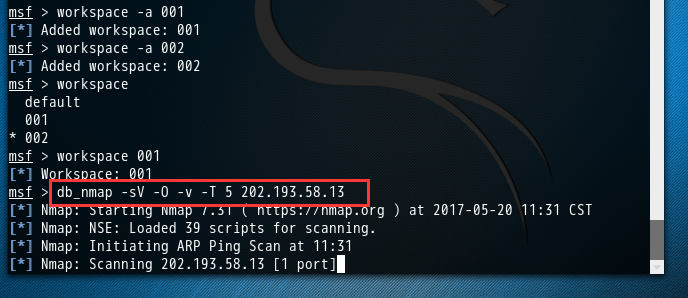
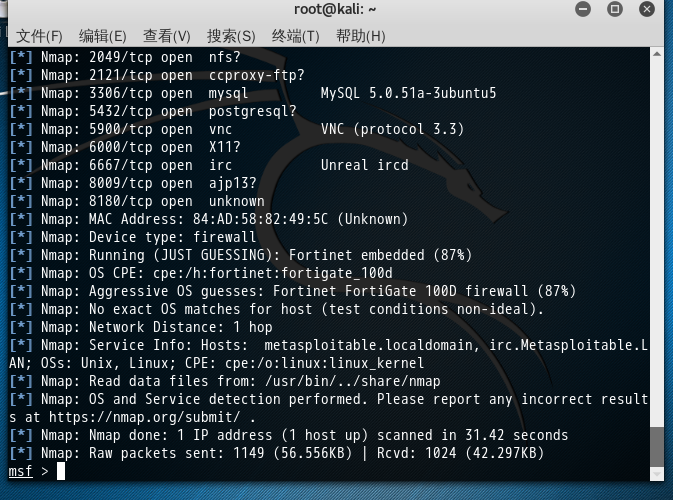
msf > workspace 001 [*] Workspace: 001 msf > db_nmap -sV -O -v -T 5 202.193.58.13 [*] Nmap: Starting Nmap 7.31 ( https://nmap.org ) at 2017-05-20 11:31 CST [*] Nmap: NSE: Loaded 39 scripts for scanning. [*] Nmap: Initiating ARP Ping Scan at 11:31 [*] Nmap: Scanning 202.193.58.13 [1 port] [*] Nmap: Completed ARP Ping Scan at 11:31, 0.01s elapsed (1 total hosts) [*] Nmap: Initiating Parallel DNS resolution of 1 host. at 11:31 [*] Nmap: Completed Parallel DNS resolution of 1 host. at 11:31, 0.02s elapsed [*] Nmap: Initiating SYN Stealth Scan at 11:31 [*] Nmap: Scanning 13.58.193.202.in-addr.arpa (202.193.58.13) [1000 ports] [*] Nmap: Discovered open port 139/tcp on 202.193.58.13 [*] Nmap: Discovered open port 22/tcp on 202.193.58.13 [*] Nmap: Discovered open port 21/tcp on 202.193.58.13 [*] Nmap: Discovered open port 445/tcp on 202.193.58.13 [*] Nmap: Discovered open port 23/tcp on 202.193.58.13 [*] Nmap: Discovered open port 80/tcp on 202.193.58.13 [*] Nmap: Discovered open port 5900/tcp on 202.193.58.13 [*] Nmap: Discovered open port 3306/tcp on 202.193.58.13 [*] Nmap: Discovered open port 25/tcp on 202.193.58.13 [*] Nmap: Discovered open port 53/tcp on 202.193.58.13 [*] Nmap: Discovered open port 111/tcp on 202.193.58.13 [*] Nmap: Discovered open port 8180/tcp on 202.193.58.13 [*] Nmap: Discovered open port 5432/tcp on 202.193.58.13 [*] Nmap: Discovered open port 512/tcp on 202.193.58.13 [*] Nmap: Discovered open port 8009/tcp on 202.193.58.13 [*] Nmap: Discovered open port 514/tcp on 202.193.58.13 [*] Nmap: Discovered open port 2121/tcp on 202.193.58.13 [*] Nmap: Discovered open port 6000/tcp on 202.193.58.13 [*] Nmap: Discovered open port 6667/tcp on 202.193.58.13 [*] Nmap: Discovered open port 513/tcp on 202.193.58.13 [*] Nmap: Discovered open port 1099/tcp on 202.193.58.13 [*] Nmap: Discovered open port 2049/tcp on 202.193.58.13 [*] Nmap: Discovered open port 1524/tcp on 202.193.58.13 [*] Nmap: Completed SYN Stealth Scan at 11:31, 0.99s elapsed (1000 total ports) [*] Nmap: Initiating Service scan at 11:31 [*] Nmap: Scanning 23 services on 13.58.193.202.in-addr.arpa (202.193.58.13) [*] Nmap: Completed Service scan at 11:32, 16.06s elapsed (23 services on 1 host) [*] Nmap: Initiating OS detection (try #1) against 13.58.193.202.in-addr.arpa (202.193.58.13) [*] Nmap: Retrying OS detection (try #2) against 13.58.193.202.in-addr.arpa (202.193.58.13) [*] Nmap: NSE: Script scanning 202.193.58.13. [*] Nmap: Initiating NSE at 11:32 [*] Nmap: Completed NSE at 11:32, 2.43s elapsed [*] Nmap: Initiating NSE at 11:32 [*] Nmap: Completed NSE at 11:32, 1.13s elapsed [*] Nmap: Nmap scan report for 13.58.193.202.in-addr.arpa (202.193.58.13) [*] Nmap: Host is up (0.0022s latency). [*] Nmap: Not shown: 977 closed ports [*] Nmap: PORT STATE SERVICE VERSION [*] Nmap: 21/tcp open ftp vsftpd 2.3.4 [*] Nmap: 22/tcp open ssh OpenSSH 4.7p1 Debian 8ubuntu1 (protocol 2.0) [*] Nmap: 23/tcp open telnet Linux telnetd [*] Nmap: 25/tcp open smtp Postfix smtpd [*] Nmap: 53/tcp open domain? [*] Nmap: 80/tcp open http? [*] Nmap: 111/tcp open rpcbind? [*] Nmap: 139/tcp open netbios-ssn? [*] Nmap: 445/tcp open microsoft-ds? [*] Nmap: 512/tcp open exec netkit-rsh rexecd [*] Nmap: 513/tcp open login? [*] Nmap: 514/tcp open shell Netkit rshd [*] Nmap: 1099/tcp open rmiregistry? [*] Nmap: 1524/tcp open shell Metasploitable root shell [*] Nmap: 2049/tcp open nfs? [*] Nmap: 2121/tcp open ccproxy-ftp? [*] Nmap: 3306/tcp open mysql MySQL 5.0.51a-3ubuntu5 [*] Nmap: 5432/tcp open postgresql? [*] Nmap: 5900/tcp open vnc VNC (protocol 3.3) [*] Nmap: 6000/tcp open X11? [*] Nmap: 6667/tcp open irc Unreal ircd [*] Nmap: 8009/tcp open ajp13? [*] Nmap: 8180/tcp open unknown [*] Nmap: MAC Address: 84:AD:58:82:49:5C (Unknown) [*] Nmap: Device type: firewall [*] Nmap: Running (JUST GUESSING): Fortinet embedded (87%) [*] Nmap: OS CPE: cpe:/h:fortinet:fortigate_100d [*] Nmap: Aggressive OS guesses: Fortinet FortiGate 100D firewall (87%) [*] Nmap: No exact OS matches for host (test conditions non-ideal). [*] Nmap: Network Distance: 1 hop [*] Nmap: Service Info: Hosts: metasploitable.localdomain, irc.Metasploitable.LAN; OSs: Unix, Linux; CPE: cpe:/o:linux:linux_kernel [*] Nmap: Read data files from: /usr/bin/../share/nmap [*] Nmap: OS and Service detection performed. Please report any incorrect results at https://nmap.org/submit/ . [*] Nmap: Nmap done: 1 IP address (1 host up) scanned in 31.42 seconds [*] Nmap: Raw packets sent: 1149 (56.556KB) | Rcvd: 1024 (42.297KB) msf >
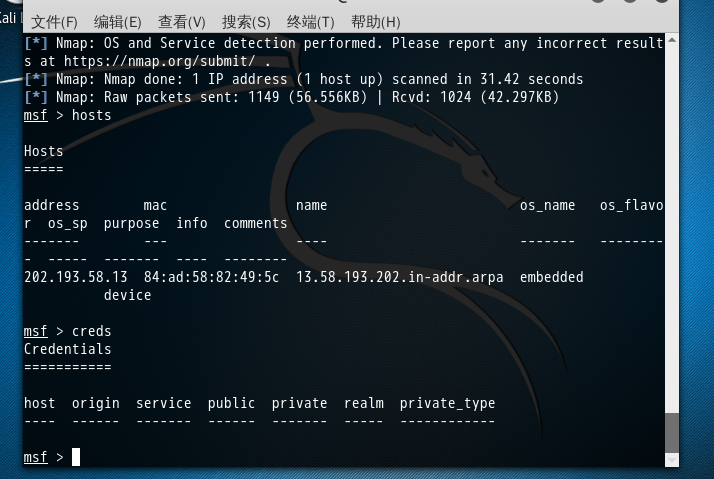
msf > hosts Hosts ===== address mac name os_name os_flavor os_sp purpose info comments ------- --- ---- ------- --------- ----- ------- ---- -------- 202.193.58.13 84:ad:58:82:49:5c 13.58.193.202.in-addr.arpa embedded device msf > creds Credentials =========== host origin service public private realm private_type ---- ------ ------- ------ ------- ----- ------------ msf >
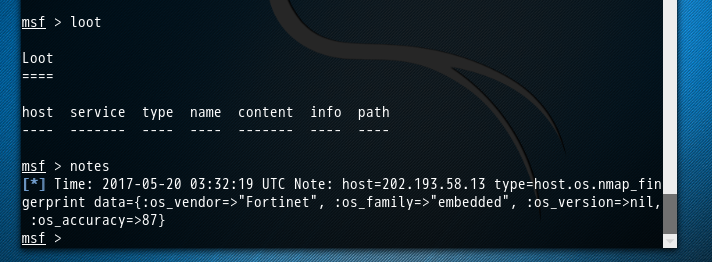
msf > loot Loot ==== host service type name content info path ---- ------- ---- ---- ------- ---- ---- msf > notes [*] Time: 2017-05-20 03:32:19 UTC Note: host=202.193.58.13 type=host.os.nmap_fingerprint data={:os_vendor=>"Fortinet", :os_family=>"embedded", :os_version=>nil, :os_accuracy=>87} msf >
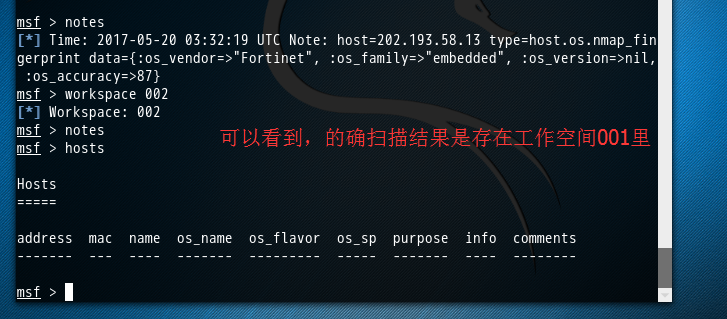
msf > notes [*] Time: 2017-05-20 03:32:19 UTC Note: host=202.193.58.13 type=host.os.nmap_fingerprint data={:os_vendor=>"Fortinet", :os_family=>"embedded", :os_version=>nil, :os_accuracy=>87} msf > workspace 002 [*] Workspace: 002 msf > notes msf > hosts Hosts ===== address mac name os_name os_flavor os_sp purpose info comments ------- --- ---- ------- --------- ----- ------- ---- -------- msf >
为什么要这么做?
答: 方便我们将扫描不同的目标或目标的不同段,进行归类。为了更好的后续工作!
本文转自大数据躺过的坑博客园博客,原文链接:http://www.cnblogs.com/zlslch/p/6880739.html,如需转载请自行联系原作者


